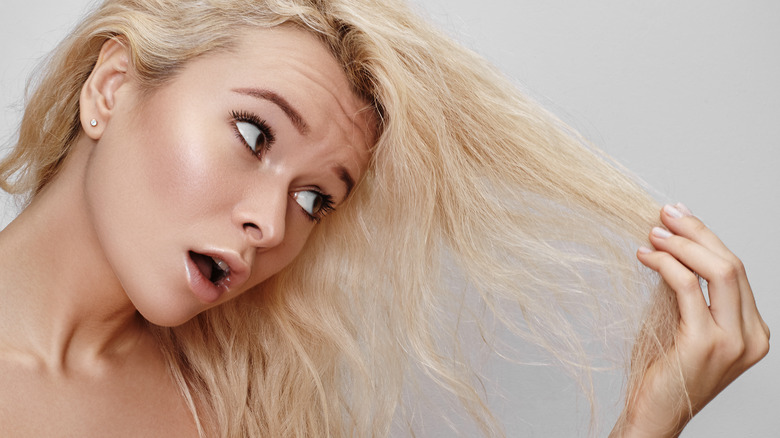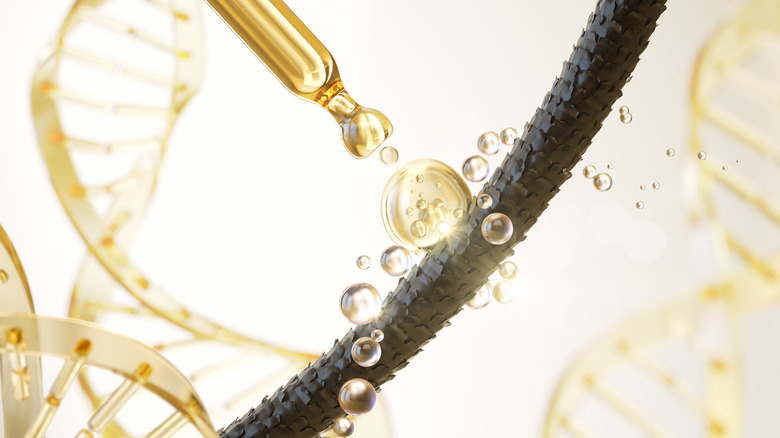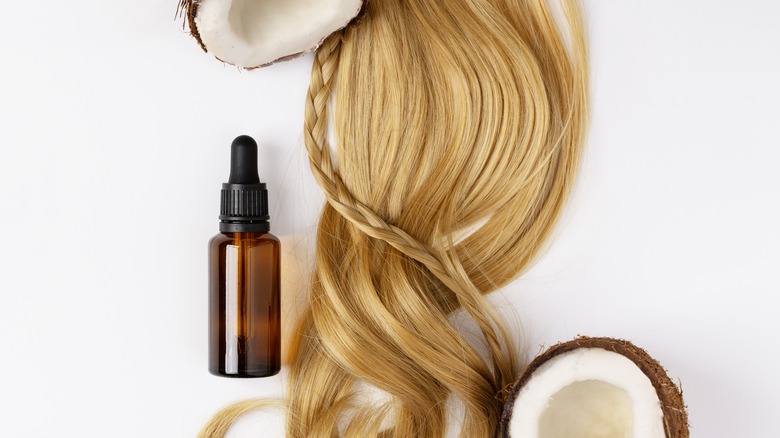How To Recover Your Hair From Bleach Damage, According To A Beauty Expert
Hair dye aficionados know that constantly changing colors may look incredible, but can have some serious drawbacks for the health and condition of your tresses. This is especially true when using bleach. While it can deliver gorgeous blond looks and the perfect canvas for other bright, saturated colors, bleach is notorious for leaving your hair dry and brittle as straw.
That's why it's important to know how often you can safely bleach your hair without completely ruining the sanctity of your strands. It also helps to recognize the signs when your hair is reaching its literal breaking point, so you can tell whether your hair is even healthy enough to bleach. After all, applying more chemical-laden bleach to fatigued hair is just asking for trouble.
Of course, if your hair has already been through the wringer of multiple bleachings, you may instead be wondering whether there's a way to undo existing stress and damage. So how can you avoid a frizzy fate and set your hair up for restorative success? We spoke to cosmetologist and stylist Ghanima Abdullah of The Right Hairstyles for an expert take on healing your hair after bleach damage.
Repair your hair's protein bonds
One of the lasting effects of bleach is damage to the proteins that keep your hair shiny and strong. So first, you'll want to prioritize this issue. "To repair bleach damage, you'll need treatments that repair the protein bonds on the inside of the hair shaft and treatments that help seal the hair cuticle, which is usually frayed in chemically damaged hair," Abdullah explains. But she goes on to reveal that not every protein treatment is created equal.
"When you look for bond repair treatments, make sure they are pH balanced or acidic," says Abdullah. "This can help close the hair cuticle, which a bad bleach treatment will leave wide open. You need to close whatever you have left of your hair cuticle because when it's open it can fray further. An open hair cuticle also permits too much water to enter the hair shaft during cleansing, causing hygral fatigue."
If you're unfamiliar with the term, hygral fatigue is essentially when hair absorbs too much water and becomes even weaker than before. As Abdullah puts it, "If your hair gets hygral fatigue, it will break off much more because the water causes it to swell and weakens the hair significantly. It also causes the hair cuticle to open widely when the hair is swollen, with very little hope of closing it again, so it usually just chips off." Long story short, frayed, open hair cuticles can lead to breakage. But protein-restoring treatments can help seal and strengthen your strands for healthier, more gorgeous locks.
Apply a protective hair oil before your shampoo
When it comes to waterproofing your damaged hair, protein repair treatments aren't the only game in town. Abdullah reveals that you can also incorporate pre-shampoo oil treatments to stop hygral fatigue in its tracks.
"Coconut oil in particular seeps into the hair shaft, strengthening the hair and not allowing the detergent and water to enter," she suggests. This is important because the damage done to your hair by too much H2O can be exacerbated by some of the ingredients lurking in your shampoo. "The main function of shampoo is to cleanse the outer part of the hair shaft, but when detergent enters the hair shaft it further corrodes it."
Using hair-friendly oils like coconut can create a barrier that prevents the harsh ingredients in your shampoo from getting inside the shaft and wreaking more havoc on your damaged strands. This makes it easier for your hair to recover from excess bleaching, instead of constantly taking two steps forward and one step back.
Use a leave-in conditioner
Once you're able to strengthen and clean your hair without compounding the harmful effects of all that bygone bleaching, you need to give it time to heal. During this crucial final step, it helps to add a layer of ongoing protection so your hair can safely repair itself without incurring more harm. "Make sure to use a leave-in conditioner," urges Abdullah. "This will provide a light seal over the entirety of the hair, softening it and keeping it from suffering further damage."
Of course, following these steps doesn't give you permission to mistreat your hair in other ways. You should also be as gentle on your tresses as possible, especially when they're still recovering from bleach damage. "Even when you have protection like this, it is just to protect the hair from mechanical damage like combing. You certainly want to avoid chemicals and heat when your hair has been damaged from bleach," Abdullah advises. So during your hair's healing journey, consider taking a break from chemical straighteners, heated styling tools, or other tricks and techniques that could end up doing more harm than good.



